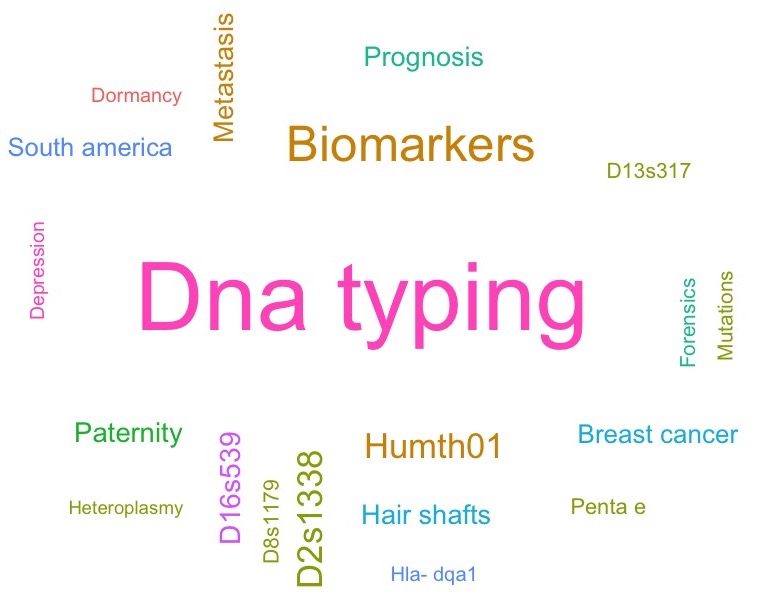
Professor of Biology
Universidad de Granada
Departamento de Medicina Legal, Toxicología y Antropología Física
e-mail: jose.lorente@genyo.es
Web: https://www.ugr.es/personal/1163f5816ae13dda8ba89d3f1812378d
Latest publications
- 2020 – High plasma levels of soluble P-Selectin and Factor VIII predict venous thromboembolism in non-small cell lung cancer patients: The Thrombo-Nsclc risk score – Thrombosis Research – 10.1016/j.thromres.2020.09.021
- 2020 – Untangled the genetic structure of Kahar and Tharu, using 23 Y chromosomal paternal lineage markers – Meta Gene – 10.1016/j.mgene.2020.100797
- 2020 – Corrigendum to “Challenges and opportunities of cfDNA analysis implementation in clinical practice: Perspective of the International Society of Liquid Biopsy (ISLB)” [Crit. Rev. Oncol. Hematol. 151 (July) (2020) 102978] (Critical Reviews in Oncology / Hematology (2020) 151, (S1040842820301165), (10.1016/j.critrevonc.2020.102978)) – Critical Reviews in Oncology/Hematology – 10.1016/j.critrevonc.2020.103058
- 2020 – Challenges and opportunities of cfDNA analysis implementation in clinical practice: Perspective of the International Society of Liquid Biopsy (ISLB) – Critical Reviews in Oncology/Hematology – 10.1016/j.critrevonc.2020.102978
- 2020 – A legal and forensic medicine approach to police physical intervention techniques in high-risk situations – International Journal of Environmental Research and Public Health – 10.3390/ijerph17082809
- 2020 – From precision medicine to imprecision medicine through limited diagnostic ability to detect low allelic frequency mutations – Translational Lung Cancer Research – 10.21037/tlcr.2020.03.07
- 2019 – Genetic structure in the paternal lineages of South East Spain revealed by the analysis of 17 Y-STRs – Scientific Reports – 10.1038/s41598-019-41580-9
- 2019 – Hydroxytyrosol inhibits cancer stem cells and the metastatic capacity of triple-negative breast cancer cell lines by the simultaneous targeting of epithelial-to-mesenchymal transition, Wnt/β-catenin and TGFβ signaling pathways – European Journal of Nutrition – 10.1007/s00394-018-1864-1
- 2019 – Cooperative and Escaping Mechanisms between Circulating Tumor Cells and Blood Constituents – Cells – 10.3390/cells8111382
- 2019 – Post-surgery circulating tumor cells and AXL overexpression as new poor prognostic biomarkers in resected lung adenocarcinoma – Cancers – 10.3390/cancers11111750
- 2019 – Population genetic data of 20 insertion-null allele markers in the Andalusian population – International Journal of Legal Medicine – 10.1007/s00414-019-02044-x
- 2019 – mRNA expression patterns in human myocardial tissue, pericardial fluid and blood, and its contribution to the diagnosis of cause of death – Forensic Science International – 10.1016/j.forsciint.2019.109876
- 2019 – The role of miRNAs as biomarkers in prostate cancer – Mutation Research – Reviews in Mutation Research – 10.1016/j.mrrev.2019.05.005
- 2019 – GSTM1 gene expression and copy number variation in prostate cancer patients—Effect of chemical exposures and physical activity – Urologic Oncology: Seminars and Original Investigations – 10.1016/j.urolonc.2018.12.010
- 2019 – Liquid biopsy beyond of cancer: Circulating pulmonary cells as biomarkers of COPD aggressivity – Critical Reviews in Oncology/Hematology – 10.1016/j.critrevonc.2019.02.003
- 2019 – EGFR detection in extracellular vesicles of breast cancer patients through immunosensor based on silica-chitosan nanoplatform – Talanta – 10.1016/j.talanta.2018.10.016
- 2019 – Exosomal miRNA profile as complementary tool in the diagnostic and prediction of treatment response in localized breast cancer under neoadjuvant chemotherapy – Breast Cancer Research – 10.1186/s13058-019-1109-0
- 2018 – Methodology for y Chromosome Capture: A complete genome sequence of y chromosome using flow cytometry, laser microdissection and magnetic streptavidin-beads – Scientific Reports – 10.1038/s41598-018-27819-x
- 2018 – Activating transcription factor 4 modulates TGFb-induced aggressiveness in triple-negative breast cancer via SMad2/3/4 and mTORC2 signaling – Clinical Cancer Research – 10.1158/1078-0432.CCR-17-3125
- 2018 – Bioactive compounds of the Mediterranean diet and prostate cancer – Aging Male – 10.1080/13685538.2018.1430129
- 2018 – Circulating tumor cells criteria (CyCAR) versus standard RECIST criteria for treatment response assessment in metastatic colorectal cancer patients – Journal of Translational Medicine – 10.1186/s12967-018-1624-2
- 2018 – Improving the genetic signature of prostate cancer, the somatic mutations – Urologic Oncology: Seminars and Original Investigations – 10.1016/j.urolonc.2018.03.012
- 2018 – Corrigendum to “Population genetic data of 38 insertion-deletion markers in South East Spanish population” – Forensic Science International: Genetics – 10.1016/j.fsigen.2018.02.021
- 2018 – The influence of nutritional factors on prostate cancer incidence and aggressiveness – Aging Male – 10.1080/13685538.2017.1379491
- 2018 – Genetic markers a landscape in prostate cancer – Mutation Research – Reviews in Mutation Research – 10.1016/j.mrrev.2017.11.004
- 2017 – Next generation sequencing: an application in forensic sciences? – Annals of Human Biology – 10.1080/03014460.2017.1375155
- 2017 – Association between polymorphisms in sex hormones synthesis and metabolism and prostate cancer aggressiveness – PLoS ONE – 10.1371/journal.pone.0185447
- 2017 – Association of circulating tumour cells with early relapse and 18F-fluorodeoxyglucose positron emission tomography uptake in resected non-small-cell lung cancers – European Journal of Cardio-thoracic Surgery – 10.1093/ejcts/ezx049
- 2017 – Somatic Mutations in Prostate Cancer: Closer to Personalized Medicine – Molecular Diagnosis and Therapy – 10.1007/s40291-016-0248-6
- 2017 – Circulating tumor cells: Markers and methodologies for enrichment and detection – Methods in Molecular Biology – 10.1007/978-1-4939-7144-2_24
- 2017 – Significance of EGFR expression in circulating tumor cells – Advances in Experimental Medicine and Biology – 10.1007/978-3-319-55947-6_16
- 2017 – A comprehensive study of circulating tumour cells at the moment of prostate cancer diagnosis: Biological and clinical implications of EGFR, AR and SNPs – Oncotarget – 10.18632/oncotarget.19718
- 2016 – Genetic variation of 17 STR loci in a Mexican Mestizo population from Mexico City – International Journal of Legal Medicine – 10.1007/s00414-016-1423-3
- 2016 – Association between RNASEL, MSR1, and ELAC2 single nucleotide polymorphisms and gene expression in prostate cancer risk – Urologic Oncology: Seminars and Original Investigations – 10.1016/j.urolonc.2016.05.018
- 2016 – Characterisation of genetic structure of the Mayan population in Guatemala by autosomal STR analysis – Annals of Human Biology – 10.3109/03014460.2015.1069891
- 2016 – Nanostructured platform integrated into a microfluidic immunosensor coupled to laser-induced fluorescence for the epithelial cancer biomarker determination – Microchemical Journal – 10.1016/j.microc.2016.03.012
- 2016 – Dormant circulating tumor cells in prostate cancer: Therapeutic, clinical and biological implications – Current Drug Targets – 10.2174/1389450116666150309121346
- 2016 – Prognostic factor analysis of circulating tumor cells in peripheral blood of patients with peritoneal carcinomatosis of colon cancer origin treated with cytoreductive surgery plus an intraoperative hyperthermic intraperitoneal chemotherapy procedure (CRS + HIPEC) – Surgery (United States) – 10.1016/j.surg.2015.09.013
- 2016 – Maternal, fetal and perinatal alterations associated with obesity, overweight and gestational diabetes: An observational cohort study (PREOBE) – BMC Public Health – 10.1186/s12889-016-2809-3
- 2016 – Circulating tumor cells identify early recurrence in patients with non-small cell lung cancer undergoing radical resection – PLoS ONE – 10.1371/journal.pone.0148659
- 2016 – The advantages of noncriminal genetic databases in identifying missing persons and human remains – Handbook of Missing Persons – 10.1007/978-3-319-40199-7_24
- 2016 – Forensic genetics against children trafficking: Missing children genetic identification – Handbook of Missing Persons – 10.1007/978-3-319-40199-7_13